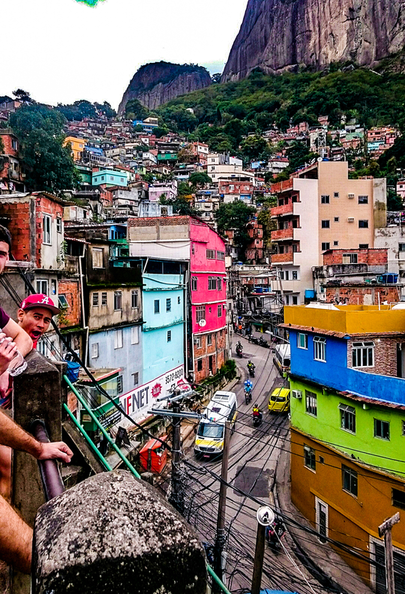Touring the Favela
With favelas having gained notoriety world-wide, it’s easy to get caught up on stereotypes. Rio de Janeiro is home to the largest favela in Brazil, Rocinha. I wanted to learn more about favela life and decided to do a tour.
Carlos (my guide) was born and raised in the favela. We met at our meeting point in Copacabana and took the bus to Rocinha. On the way, he asked me a very interesting question; why were we taking the bus as opposed to meeting him there? Despite the stories of drugs and violence, the favela is full of real humans living real lives. The most disrespectful thing to do would be to drive in, take pictures (like we were in a zoo), and drive off. By taking the bus, we were entering at a local level and this instantly struck a chord with me, as now, we were really entering the heart of a Brazilian FAVELA.
We got off the bus on a busy road and it was clear that we weren’t in the organised surroundings of Copacabana anymore! Motor bikes beeped and whizzed past us, street vendors haggled with customers, food stalls sizzled with food., funk music blared. The hustle and bustle of the favela was well and truly here! As we walked, Carlos explained how the favela came about and how it grew. He talked about growing up in Rocinha and some of the hardships people face, and showed some of the amazing ways they overcame them. His knowledge was incredible. Rocinha developed on a hill and there are many steep steps within alley ways that take you from the main road, deep into the favela and can show the city’s most authentic sights. You see the masses of houses, sprawling around you. Young children are kicking around a football, locals eating, having a drink. In the distance Christ the Redeemer stands tall.

The view from Rocinha
One of the most beautiful things about the favelas is their informal nature and with no official government planning, you can find some truly innovative and creative developments. From narrow alleys to large streets, houses upon houses upon houses. The favela is a remarkable place.
Our tour ended with a typical Brazilian buffet lunch. I was keen to learn about the stereotypes that favelas have and surprised with how positive the tour had been. The security in the favela, ironically comes from drug lords. Problems in the favela causes problems with their business and can attract unwanted police attention. Favelas have the potential to be some of the most dangerous places in the world, however the safest I felt in the whole of Brazil was when I was in Rocinha. Ironic right? Nevertheless, trouble does kick off.
"Bullets smashed the window and ricocheted off the walls..."
Our conversation was overheard by another resident and he told me how there had been a shoot out the night before. In the middle of the night, he was forced to grab his two daughters and hide in the bathroom as he tried to protect them from the bullets whizzing above their heads. It was a crazy story, but one which brings back the harsh and volatile reality of favela life.
How to do the tour
The tour eventually finished and Carlos helped me get the bus back to Copacabana. The tour was done with www.favelatour.org. The company is run by Zezinho, a resident of Rocinha. All the money earnt goes directly back into helping improve the community. Recently, he has used his profits to buy DJ equipment, offering free DJ’ing classes to the children of Rocinha. The work done by Zezinho is inspirational and I would personally recommend this favela tour!

@originalworks
The @OriginalWorks bot has determined this post by @dippy-rascal to be original material and upvoted it!
To call @OriginalWorks, simply reply to any post with @originalworks or !originalworks in your message!